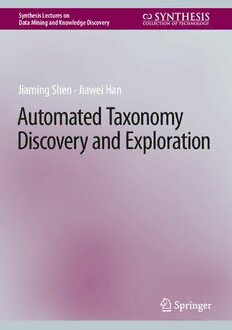Table Of ContentSynthesis Lectures on
Data Mining and Knowledge Discovery
Jiaming Shen · Jiawei Han
Automated Taxonomy
Discovery and Exploration
Synthesis Lectures on Data Mining
and Knowledge Discovery
SeriesEditors
JiaweiHan,atUrbana-Champaign,UniversityofIllinois,URBANA,IL,USA
LiseGetoor,UniversityofCalifornia,SantaCruz,SantaCruz,USA
JohannesGehrke,MicrosoftCorporation,Redmond,WA,USA
The series focuses on topics pertaining to data mining, web mining, text mining, and
knowledge discovery, including tutorials and case studies. Potential topics include: data
miningalgorithms,innovativedataminingapplications,dataminingsystems,miningtext,
webandsemi-structureddata,highperformanceandparallel/distributeddatamining,data
mining standards, data mining and knowledge discovery framework and process, data
mining foundations, mining data streams and sensor data, mining multi-media data, min-
ingsocialnetworksandgraphdata,miningspatialandtemporaldata,pre-processingand
post-processing in data mining, robust and scalable statistical methods, security, privacy,
and adversarial data mining, visual data mining, visual analytics, and data visualization.
Jiaming Shen · Jiawei Han
Automated Taxonomy
Discovery and Exploration
JiamingShen JiaweiHan
GoogleResearch UniversityofIllinoisUrbana-Champaign
NewYorkCity,NY,USA Urbana,IL,USA
ISSN2151-0067 ISSN2151-0075 (electronic)
SynthesisLecturesonDataMiningandKnowledgeDiscovery
ISBN978-3-031-11404-5 ISBN978-3-031-11405-2 (eBook)
https://doi.org/10.1007/978-3-031-11405-2
©TheEditor(s)(ifapplicable)andTheAuthor(s),underexclusivelicensetoSpringerNature
SwitzerlandAG2022
Thisworkissubjecttocopyright.AllrightsaresolelyandexclusivelylicensedbythePublisher,whetherthewhole
orpartofthematerialisconcerned,specificallytherightsoftranslation,reprinting,reuseofillustrations,recitation,
broadcasting,reproductiononmicrofilmsorinanyotherphysicalway,andtransmissionorinformationstorage
andretrieval,electronicadaptation,computersoftware,orbysimilarordissimilarmethodologynowknownor
hereafterdeveloped.
Theuseofgeneraldescriptivenames,registerednames,trademarks,servicemarks,etc.inthispublicationdoes
notimply,evenintheabsenceofaspecificstatement,thatsuchnamesareexemptfromtherelevantprotective
lawsandregulationsandthereforefreeforgeneraluse.
Thepublisher,theauthors,andtheeditorsaresafetoassumethattheadviceandinformationinthisbookare
believedtobetrueandaccurateatthedateofpublication.Neitherthepublishernortheauthorsortheeditorsgive
awarranty,expressedorimplied,withrespecttothematerialcontainedhereinorforanyerrorsoromissionsthat
mayhavebeenmade.Thepublisherremainsneutralwithregardtojurisdictionalclaimsinpublishedmapsand
institutionalaffiliations.
ThisSpringerimprintispublishedbytheregisteredcompanySpringerNatureSwitzerlandAG
Theregisteredcompanyaddressis:Gewerbestrasse11,6330Cham,Switzerland
Tomyfamilyfortheirloveandsupport.
Preface
In today’s information era, people are inundated with vast amounts of text data. Every
day,therearethousandsofscientificpapers,tensofthousandsofnewsarticles,corporate
reports,andmillionsofsocialmediapostsproducedandsharedworldwide.Turningthose
massive text data into actionable knowledge is an essential research issue in data science
and lays the foundation for realizing machine intelligence.
Inthisbook,wediscusshowtounleashhiddenknowledgeburiedinunstructuredtext.
We propose to first structure raw text using taxonomies and then analyze structured text
in a more fine-grained and semantic way. Due to the diversity of application scenarios,
different corpora or different use cases may call for different taxonomies. For example,
one analyst aiming to find experts in different scientific areas may want a field-of-study
taxonomy, while another analyst who studies the technology readiness may call for a
taxonomy capturing technology dependencies. Moreover, even within one taxonomy, we
also enable users to organize concepts at their will, such as with different levels con-
taining concepts of different categories. For instance, in a computer science taxonomy,
top levels could be about fieldofstudies, intermediate levels may discuss researchtasks,
and the bottom levels can cover evaluation metrics. Asking human experts to manually
curate those taxonomies, one for every possible application, is time-consuming, costly,
and unscalable. Therefore, we propose to automatically discover and explore taxonomies
based on the datasets and applications, with critical but minimal human guidance.
This book outlines a data-driven approach that automatically constructs, enriches, and
appliestaxonomiesforunleashingknowledgefrommassiveunstructuredtext.Particularly,
we investigate four areas of research, including:
1. ConceptSetDiscovery. To obtain concept nodes in the taxonomy, we first develop a
collection of concept set expansion methods to extract concepts from text corpora by
expanding a small set of seed concepts into a complete list of concepts that belong to
the same semantic class.
2. Taxonomy Construction. To organize above identified concepts into hierarchical
structure, we propose a set of taxonomy construction methods to discover taxonomic
relations among concepts by analyzing example relation instances (i.e. , concept pairs
vii
viii Preface
indicatingthetargetrelationsemantics)andutilizingdistantsupervisionfromexisting,
open-domain knowledge bases.
3. Taxonomy Enrichment. As human knowledge is constantly growing, a static tax-
onomy may fail to capture emerging user needs. Thus, a taxonomy enrichment step
would be essential to keep our taxonomies up-to-date in real-world applications. We
facilitate this process by expanding the taxonomy to incorporate new concepts.
4. Taxonomy-Guided Classification. After an up-to-date taxonomy is obtained, we
develop principled methods to leverage taxonomies for classification tasks.
Together, these pieces constitute an integrated framework for leveraging taxonomies to
convert massive text data into actionable knowledge.
New York City, USA Jiaming Shen
Contents
1 Introduction ......................................................... 1
1.1 Overview ....................................................... 1
1.2 Technical Roadmap ............................................... 4
1.2.1 Concept Set Expansion ..................................... 4
1.2.2 Taxonomy Construction .................................... 4
1.2.3 Taxonomy Enrichment ..................................... 5
1.2.4 Taxonomy-Guided Classification ............................. 5
1.3 Organization ..................................................... 6
References ........................................................... 6
2 ConceptSetExpansion ............................................... 9
2.1 Overview and Motivations ......................................... 9
2.2 Related Work .................................................... 11
2.3 SetExpan: Weakly-Supervised Concept Set Expansion ................ 12
2.3.1 Data Model and Context Features ............................ 12
2.3.2 Context-Dependent Concept Similarity ....................... 14
2.3.3 Context Feature Selection ................................... 14
2.3.4 Concept Selection via Rank Ensemble ........................ 15
2.4 Experiments ..................................................... 17
2.4.1 Datasets .................................................. 17
2.4.2 Compared Methods ........................................ 18
2.4.3 Evaluation Metrics ......................................... 19
2.4.4 Overall Performance ....................................... 19
2.4.5 Ablation Studies ........................................... 21
2.4.6 Case Studies .............................................. 23
2.5 Extensions of SetExpan ........................................... 24
2.5.1 Addressing Concept Drifts via Auxiliary Sets Generation
and Co-expansion .......................................... 24
2.5.2 Probing Knowledge from Pre-trained Language Models ........ 25
ix
x Contents
2.6 Summary ....................................................... 27
References ........................................................... 27
3 TaxonomyConstruction .............................................. 31
3.1 Overview and Motivations ......................................... 31
3.2 Related Work .................................................... 33
3.3 HiExpan: Task-Guided Concept Taxonomy Construction .............. 34
3.3.1 Problem Formulation ....................................... 34
3.3.2 Framework Overview ...................................... 35
3.3.3 Key Term Extraction ....................................... 35
3.3.4 Iterative Width and Depth Expansion ......................... 36
3.3.5 Taxonomy Global Optimization .............................. 39
3.4 Experiments ..................................................... 40
3.4.1 Datasets .................................................. 40
3.4.2 Compared Methods ........................................ 41
3.4.3 Evaluation Metrics ......................................... 41
3.4.4 Quantitative Results ........................................ 42
3.4.5 Case Studies .............................................. 43
3.5 Summary ....................................................... 44
References ........................................................... 45
4 TaxonomyEnrichment ................................................ 49
4.1 Overview and Motivations ......................................... 49
4.2 Related Work .................................................... 51
4.3 TaxoExpan: Self-supervised Taxonomy Expansion .................... 52
4.3.1 Problem Formulation ....................................... 52
4.3.2 Taxonomy Modeling and Expansion Goal ..................... 53
4.3.3 Query-Anchor Matching Model .............................. 54
4.3.4 Model Learning and Inference ............................... 58
4.4 Experiments ..................................................... 61
4.4.1 Experiments on MAG Dataset ............................... 61
4.4.2 Experiments on SemEval Dataset ............................ 69
4.5 Extensions of TaxoExpan ......................................... 71
4.5.1 Incorporating More Fine-Grained Self-supervision Tasks ........ 71
4.5.2 Identifying Potential Children Concepts ...................... 73
4.5.3 Modeling Relations Among News Concepts ................... 75
4.6 Summary ....................................................... 78
References ........................................................... 79
5 Taxonomy-GuidedClassification ....................................... 83
5.1 Overview and Motivations ......................................... 83
5.2 Related Work .................................................... 85

